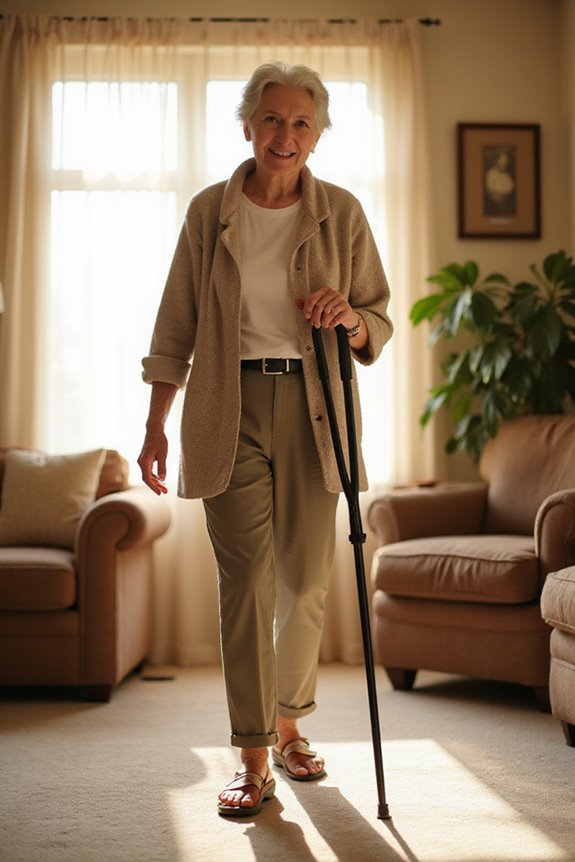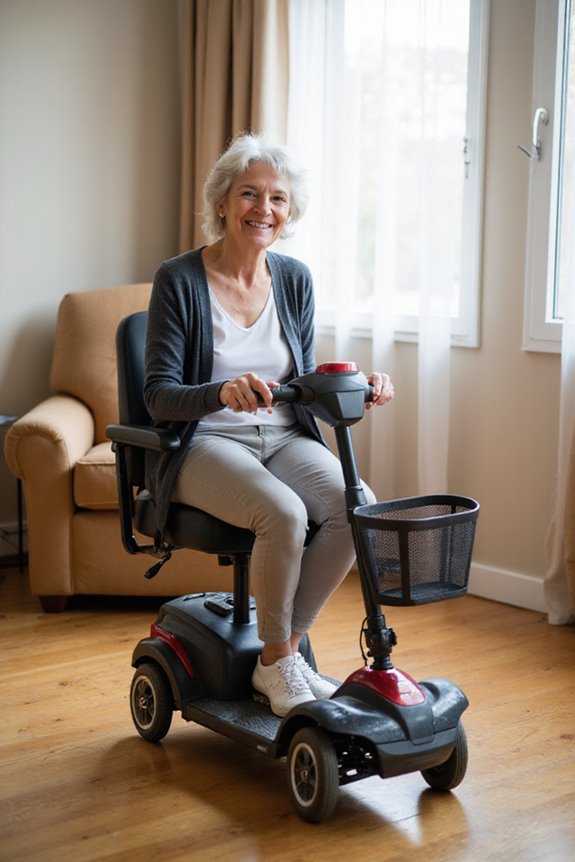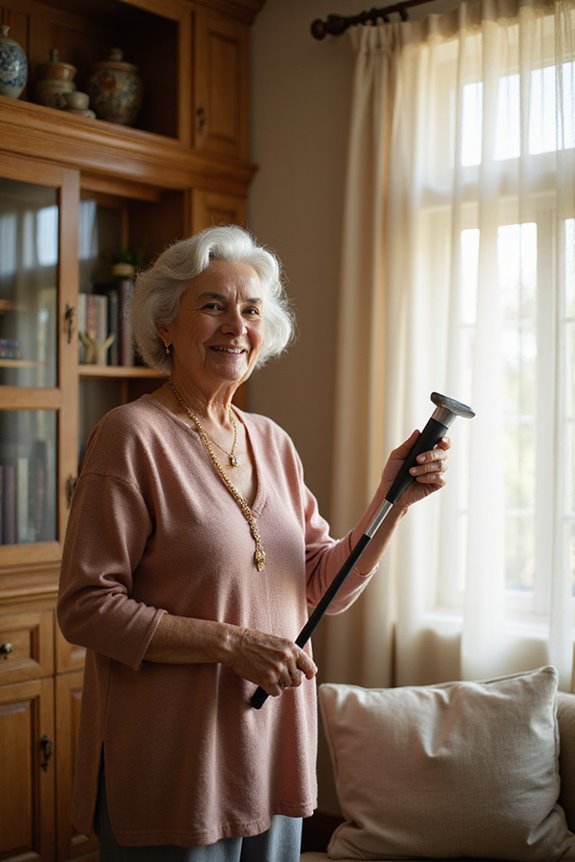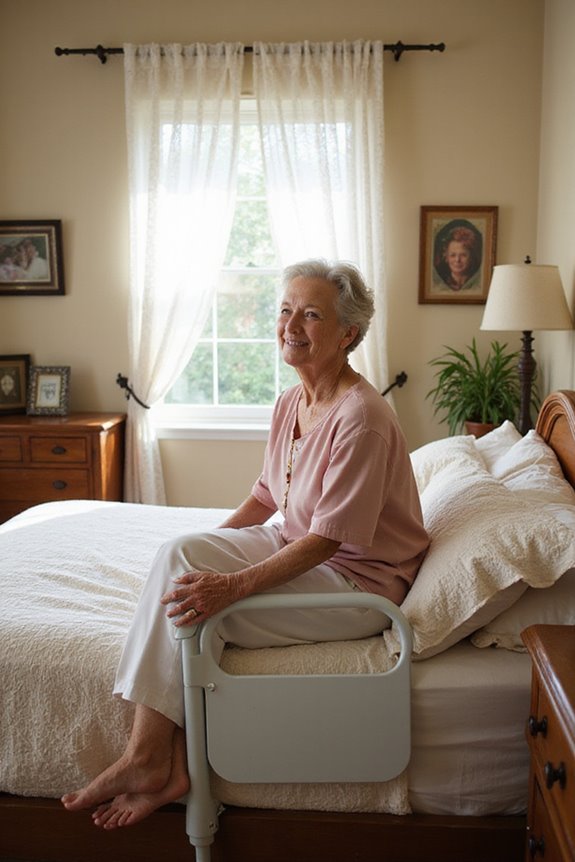To choose the right mobility aid, assess individual abilities and needs, considering physical capability, environmental factors, and financial implications. Types of aids include canes, crutches, walkers, and wheelchairs, each serving different levels of mobility deficits. Evaluate costs, insurance coverage, and maintenance requirements. Professional assessments can provide insights tailored to specific situations. Testing aids in real-world settings is essential for comfort and functionality. Further insights can enhance the decision-making process for ideal mobility support.
Key Takeaways
- Assess your physical capabilities, including strength, balance, and mobility limitations, to determine the most suitable aid.
- Consider the types of mobility aids available, like canes, walkers, or wheelchairs, based on your specific needs.
- Evaluate the environmental factors affecting mobility, such as uneven surfaces and weather conditions, to ensure safe usage.
- Understand the financial implications, including costs and insurance coverage, to select an aid that fits your budget.
- Test mobility aids through trial periods to ensure comfort, functionality, and compatibility with your daily activities.
Assessing Your Abilities and Needs
Evaluating an individual’s abilities and needs is critical in determining the most suitable mobility aid. A detailed assessment includes:
- Physical Capability Evaluation: Measure strength, joint range of motion, balance, and gait to identify personal health factors and activity limitations.
- Functional Activity Assessment: Identify mobility-related activities of daily living (MRADLs) affected, observing whether tasks require assistance and documenting completion times.
- Environmental Consideration: Assess the settings where mobility aids will be used, confirming compatibility with physical spaces and conditions.
- Person-Specific Needs and Preferences: Consider medical conditions, comfort, and cognitive ability to navigate devices independently. Understanding the average lifespan of a walker can also help in planning for future needs as it ranges from 5 to 10 years, influenced by material and maintenance.
Conducting a thorough evaluation guarantees the selected mobility aid aligns with individual needs while fostering a sense of belonging and independence.
Understanding Different Types of Mobility Aids

Understanding the various types of mobility aids is essential for individuals seeking to enhance their independence and mobility.
Canes Overview
- Single-point canes offer basic support for mild mobility issues.
- Multiple-point canes provide increased stability for users needing more assistance.
- Folding canes are compact and height adjustable.
- Seat canes incorporate a foldable seat for resting.
Crutches Comparison
- Axillary crutches support weight through underarm padding, ideal for short-term use.
- Lofstrand crutches allow for long-term use with less irritation.
- Platform crutches are beneficial for users with weak grip strength.
Walkers Features
- Standard walkers require lifting, while rollators allow pushing.
- Knee walkers support injured legs, and gutter frames assist those with grip issues.
Wheelchair Types
– Manual wheelchairs are user-propelled, while power wheelchairs offer electric mobility options.
Additionally, incorporating grab bars can significantly improve safety and stability in various environments, particularly in bathrooms and stairways.
Evaluating Environmental Considerations
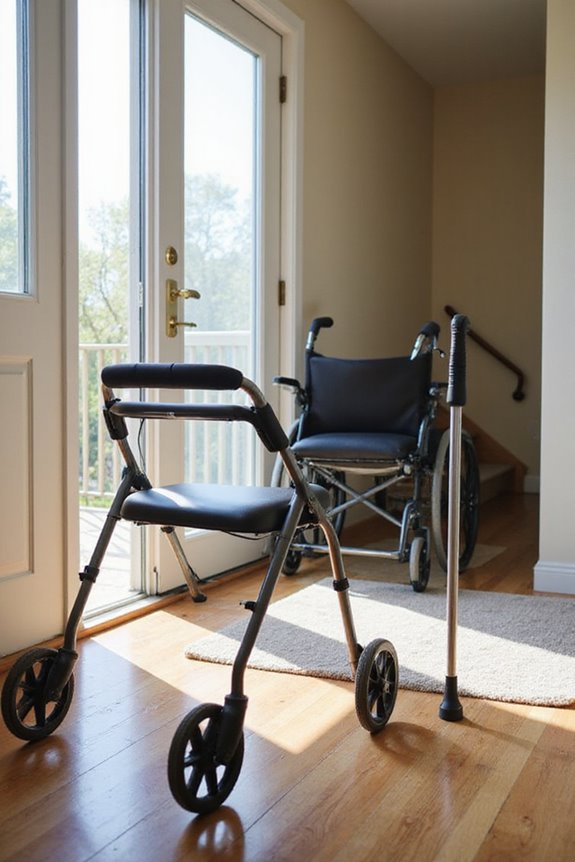
How can environmental factors influence the effectiveness of mobility aids?
- Weather Conditions: Rain, snow, and ice can compromise safety. Slippery pathways increase fall risk, necessitating durable, weather-resistant aids.
- Urban Planning: Well-maintained sidewalks, ramps, and curb cuts are essential for mobility aid users. Inclusive public transportation options must accommodate various devices.
- Infrastructure: Uneven pavements and stairs without alternatives hinder navigation. Regular maintenance is vital to clear obstacles like debris or snow.
- Accessibility: Creating walkable, barrier-free spaces enhances mobility and community inclusivity. Integrating user-friendly operation into the design of mobility aids can greatly influence user independence and safety, promoting a more accessible environment for all.
Considering Financial Implications
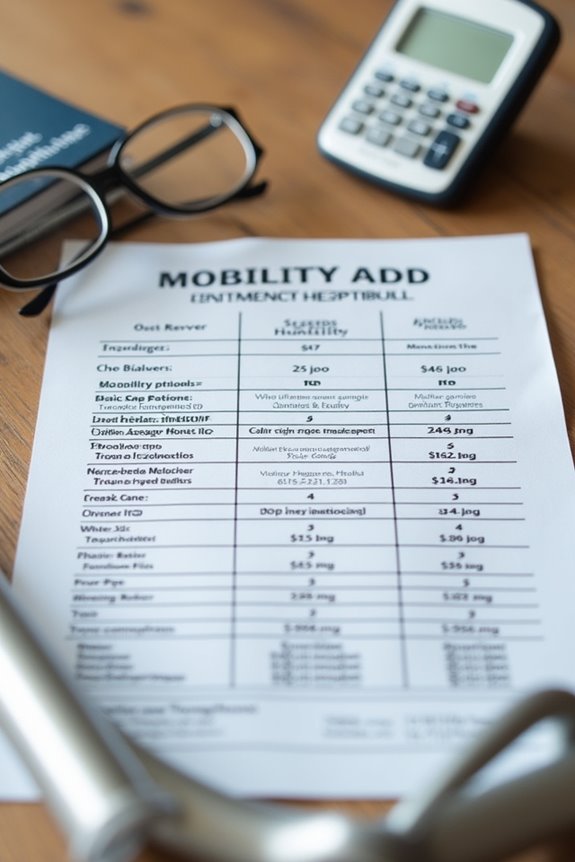
Considering financial implications is critical when selecting mobility aids, as various costs can greatly impact the user’s budget. Effective budget planning involves understanding both immediate and long-term expenses associated with mobility aids.
- Costs: Standard canes range from $15 to $35; walkers are $40 to $200; power scooters can exceed $4,000.
- Insurance Coverage: Medicare Part B covers 80% of approved equipment post-physician recommendation, while private plans may offer varying coverage.
- Assistance Programs: Medicaid and charitable organizations provide financial support, particularly for those with disabilities.
Users should meticulously compare prices, assess insurance options, and explore available assistance programs to guarantee affordability and maintain financial stability when choosing mobility aids. Understanding the average lifespan of mobility aids can also help in making informed purchasing decisions to avoid frequent replacements.
The Role of Professional Assessment
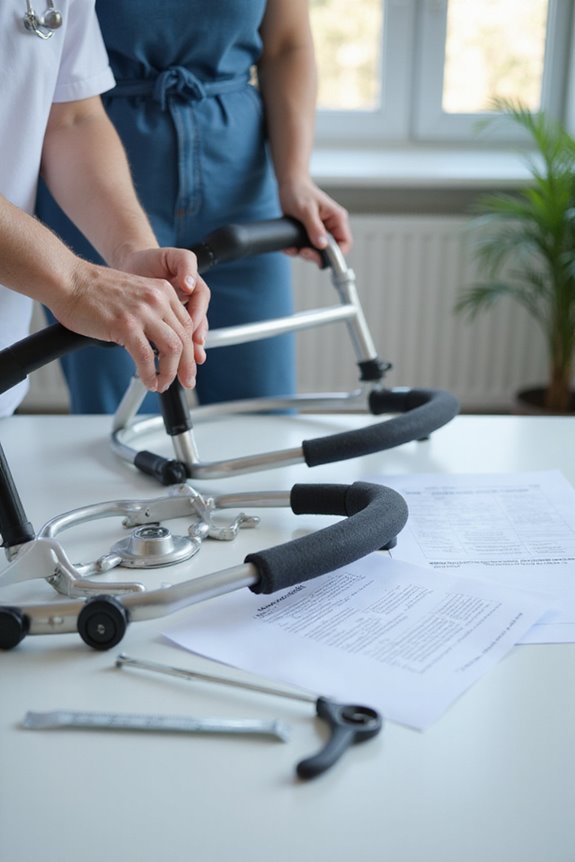
The role of professional assessment is pivotal in the selection of mobility aids, as it provides a structured framework for understanding the specific needs and capabilities of the user. This client-centered approach involves several key components:
- Assessment Process: Includes interviews to gather information about mobility status and goals.
- Identifying Needs: Assesses primary problems such as mobility impairments and postural support requirements.
- Customization: Achieved through body measurements and user need evaluations.
- Health Considerations: Previous health interventions inform the assessment.
- Functional Evaluation: Evaluates the user’s ability to navigate their environment effectively. Additionally, a thorough assessment can help determine the most suitable braking systems to enhance user safety and control during mobility.
Testing and Trying Out Mobility Devices
Testing mobility devices in real-world environments is essential to guarantee ideal functionality and user satisfaction.
Trial Periods: Engaging in trial periods allows users to experience comfort, maneuverability, and safety firsthand.
User Feedback: Gathering user feedback during these trials helps identify any unforeseen issues regarding device performance.
Real World Testing: Testing in various settings—home, work, and outdoors—ensures environmental compatibility and adaptability to diverse terrains.
Comfort Assessment: A thorough comfort assessment addresses pressure points and postural support, fostering psychological adaptation.
Performance Evaluations: Objective performance evaluations, such as the Timed Up and Go test, illuminate user capability and device effectiveness. Additionally, height adjustability features play a crucial role in ensuring the cane is tailored to individual needs.
Ultimately, extensive testing leads to informed decisions regarding the most suitable mobility aid, promoting both functionality and user confidence.
Maintenance and Longevity of Mobility Aids
Mobility aids require consistent maintenance to secure their longevity and top performance.
Battery Maintenance
Regular charging and inspection of batteries are vital for peak function.
Cleaning Routines
Routine cleaning prevents corrosion and mechanical wear, extending device life.
Inspection Schedules
Frequent checks for loose bolts and worn components are important to avoid accidents.
Professional Servicing
Scheduled professional maintenance can greatly enhance lifespan and guarantee safe operation.
Component Upgrades
Proactive upgrades, such as replacing motors or batteries, can extend usability.
Lifespan Factors
Factors influencing longevity include usage frequency, material durability, and environmental exposure. Additionally, ensuring proper weight capacity is crucial as it affects the overall integrity and safety of the mobility aid during use.
Frequently Asked Questions
How Do I Know if I Need a Mobility Aid?
A mobility assessment reveals if an individual requires assistance. Lifestyle considerations, such as daily activities and safety concerns, play an essential role in determining the need for a mobility aid to enhance overall well-being and independence.
Can I Use Multiple Mobility Aids Simultaneously?
Using multiple mobility aids simultaneously can enhance independence but requires careful consideration of individual capabilities. Combining aids effectively involves tailored mobility strategies, ensuring safety and functionality while accommodating physical and cognitive limitations for ideal user experience.
What Should I Do if My Mobility Aid Breaks?
When a mobility aid breaks, exploring repair options becomes essential. Seeking emergency solutions, contacting professionals, or utilizing a personal repair kit can guarantee safety and maintain independence, fostering a sense of belonging within a supportive community.
How Can I Improve My Upper Body Strength for Crutches?
To improve upper body strength for crutch users, engaging in upper body exercises like bicep curls and triceps extensions enhances strength training. This commitment fosters belonging, promoting confidence and independence during mobility challenges.
Are There Mobility Aids Designed Specifically for Outdoor Use?
Like a trusted friend guiding the way, outdoor wheelchairs and all-terrain walkers empower individuals to explore nature confidently. These aids enhance accessibility and provide a sense of belonging in outdoor spaces, fostering independence and adventure.


